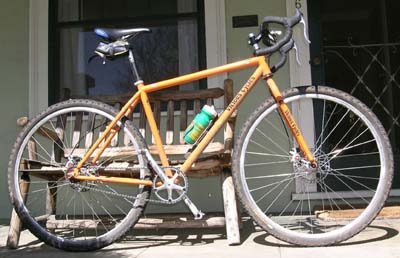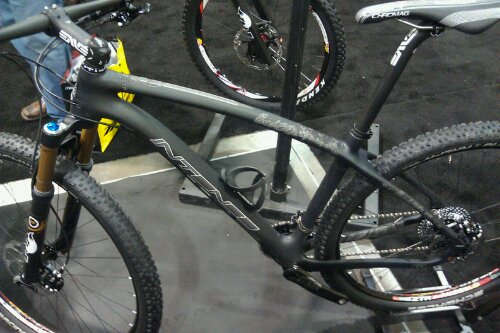Interbike 2011 is over, and I’m still trying to process the bigger picture. Many things were witnessed at the Sands Expo, but it always takes a while to knit together the pieces and come up with some best-in-shows, catch the zeitgeist, and figure out the meaning. I don’t know that I’ve sorted all of that out yet, but, after much consideration, I’ve come up with a few observations.
No Going Back Now on 29ers

Vicious Cycles The Motivator Owned by Paul of Paul Components
It was clear at this year’s show that the tipping point has been reached. All companies now need both a carbon fiber 29er and a full-suspension 29er in their lineup, and preferably a bike that offers both carbon fiber and a bitchin’ suspension design. Those left offering only bikes with 26″ wheels better hope Europe never gets the memo that 99% of their riding would make more sense with bigger wheels or that synthetic bull bile doesn’t kill off the “extreme” demographic.
I’m not bemoaning the success of my preferred wheel size, and I don’t mean to be one of those bitter, old guys who refuses to wear a CBGB shirt because he’s actually been to CBGB’s. I love big wheels enough to share, and I’m glad they’re everywhere. If guys like Carl Schlemowitz and Wes Williams had figured out how to patent using 700c road bike rims on a mountain bike, maybe the “magic” would still be there, but magic’s a poor substitute for tire, rim, and fork selection. We should all be happy there are now two viable wheel options are represented on the market.
Still, it’s tough to see so little credit going where it’s due–particularly since we’re now in the “collective amnesia” phase of big wheel adoption, wherein everybody has one, and is obligated to act as if they always have, while the guys who took all the chances can’t afford booth space at the show.
Go Big (Numbers) or Go Home

Intense Keeping Up with the Joneses for Carbon Fiber
In a time when America is wondering where its manufacturing jobs have gone and how to get some back, the bike industry presents a stark reality: U.S. manufacturing can’t compete with the products coming out of China and Taiwan. The Intense Cycles booth–drastically smaller than in years past–was displaying two carbon fiber bikes. The Carbine full-suspension trail bike and Hard Eddie hardtail 29er certainly give small frame builder Intense a much needed update, but with the introduction of these outsourced frames, the brand that built their entire reputation on “Made in the U.S.A.” seems to be finally bowing to the pressure of overseas production.
And can you blame them? Quick quiz: which frame sold more units?
- Intense Spider 29
- Santa Cruz Tallboy
Not really a contest, that. The Tallboy might’s well have added a jet engine to Santa Cruz sales. The Spider 29 can’t compare.
Thing is: you can only convince people to buy a U.S. made product at a premium if there’s a tangible advantage the consumer can use to justify the purchase. When a much lighter, much stiffer, and just better all-around frame is available for a similar price, the U.S. consumer is going to vote for overseas production. To meet that demand, a manufacturer like Intense needs to go overseas. Apparently, at the end of the day, there just aren’t any facilities in the U.S. capable of producing a carbon fiber bicycle frame for anywhere near the cost of Taiwan or China, the two most likely places of origin for the apparently German-designed, U.S.-assembled Intense carbon fiber bikes.
And that sucks.
Sure, you’ll still be able to feel pretty elite and bereft of spending cash by buying a bike only America can produce, and I don’t think Richard Sachs is going to be searching alibaba.com for a production partner any time soon, but anyone who thinks Steber at Intense didn’t have a gun pointed at his head on this one just isn’t paying attention to the global economy. Intense was forced to produce two new bike frames–probably what will be their best selling frames ever–outside of the U.S.
My question isn’t, “How can we make affordable carbon fiber frames in the U.S.?” Right now, we can’t. My question is, “Where’s our bicycle fabrication equivalent of SSC?” Would it be possible for the U.S. to produce a bike so over the top, from a design and engineering perspective, that every other mountain bike would dream of being that bike? Might be pure stupidity, but I’m still holding out hope for the answer to that one.

Sorry, the comment form is closed at this time.